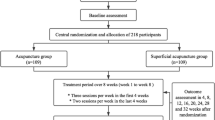Abstract
In an earlier study the authors reported on the relative effectiveness of three psychological methods of treating tension headache. This paper reports follow-up data on each procedure and focuses on variables seemingly related to long-term success. Follow-up occurred at 3, 6, and 12 months and involved I week of self-report records of headache activity and medication dosage. For the 30 original subjects, follow-up information was available for 23, 20, and 18 subjects, respectively, at each of the three follow-up periods. Questionnaire and physiological data indicated that the type of treatment offered was relevant only in explaining initial success. Continued practice of relaxation procedures seemed more important in explaining long-term outcomes. The relationship between type of training and continuing practice seemed to involve seveal heretofore unspecified “placebo” variables, which were explored and found to influence long-term success rates. Treatment procedures can presumably be modified to include these new variables, thus strengthening this therapeutic process.
Similar content being viewed by others
References
Benson, H.The relaxation response. New York: William Morrow, 1975.
Budzynski, T., Stoyva, J., Adler, C., & Mullaney, D. EMG biofeedback and tension headaache: A controlled outcome study.Psychosomatic Medicine 1973,35 484–496.
Hutchings, D., & Reinking, R. Tension headaches: What form of therapy is most effective?Biofeedback and Self-Regulation 1976,1 169–183.
Luthe, W. (Ed.).Autogenic therapy. New York: Grune and Stratton, 1969.
Miller, N. Introduction: Current issues and key problems. In N. Miller, T. Barker, L. DiCara, J. Kamiya, D. Shapiro, & J. Stoyva (Eds.),Biofeedback and self-control. Chicago: Aldine, 1974. Pp. xi-xviii.
Rotter, J. Generalized expectancies for internal versus external control of reinforcement.Psychological Monographs, 1966,80(1, Whole No. 609).
Sargent, J., Greene, E., & Walters, E. Preliminary report on the use of autogenic feedback training in the treatment of migraine and tension headaches.Psychosomatic Medicine 1973,35 129–135.
Wolpe, J., & Lazarus, A.Behavior therapy techniques. New York: Pergamon Press, 1966.
Author information
Authors and Affiliations
Rights and permissions
About this article
Cite this article
Reinking, R.H., Hutchings, D. Follow-up to. Biofeedback and Self-Regulation 6, 57–62 (1981). https://doi.org/10.1007/BF00998793
Received:
Issue Date:
DOI: https://doi.org/10.1007/BF00998793




